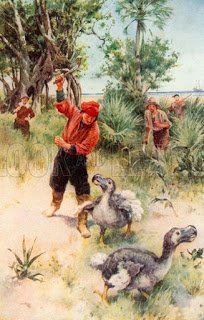Dodo birds are large birds in habitat on Mauritius Island in the Indian Ocean that can not fly and have gone extinct.
Before it was confirmed extinct, this bird covered many myths, until finally Harry Higginson and George Clark discovered the fossil bird Dodo in 1865.
Facts about Dodo's Bird#
- The first Latin name given by Carl Linnaeus to this bird is 'Didius ineptus' which means 'incompetent dodo (unable to fly)'.
However, today scientists prefer to call it 'Raphus cucullatus'
- The main predator of Dodo birds is the Dutch sailors (and animals brought with them) who stop by on their way to the Indonesian Archipelago.
Dodo was hunted by the first sailors and settlers on the island. Although Dodo's meat is described as hard-textured, it does not stop the explorers from prey on this bird for food.
The Dutch sailors dub Dodo as a 'valghvogel' which translates into 'disgusting bird' because of its unpleasant taste of meat.
- The character of Dodo in Alice Adventures in Wonderland is inspired by Dodo's skeletons kept at the Oxford University Museum of Natural History.
Contrary to the popular myth associated with this bird, the author of Alice's book, Lewis Carroll (having the pseudonym of Charles Dodgson), describes this bird as a wise creature.
Some people believe that Dodo's character in Alice's book is a self-portrayal of the author.
- After going through DNA testing of the remaining soft tissues, it is evident that the dodo is a close relative of the Nicobar dove.
Interestingly enough, when Johannes Theodor Reinhardt, a zoologist, proposed the theory that Dodo was a kind of land pigeon, he received much criticism from his colleagues.
- Some live Dodo birds have ever been sent to Europe to be shown to the public.
The living specimen was used as a model because at that time there was no camera.
- The tambalacoque tree or dodo tree (Sideroxylon grandiflorum) has been mistakenly linked to the extinction of this bird.
Previously believed that the seeds of this tree must pass through the digestive tract of Dodo in order to germinate.
Although a rare tree, but tambalacoque can still be found after Dodo's death.
Physical appearance#
Dodo's birds went extinct before the start of the camera era so over the years, people had to rely on paintings and written descriptions from the 17th century to describe this bird.
Many of the popular paintings by artists depict Dodo has a fat body and up to 1 meter tall and strong bodied.
However, the credibility of these paintings was once considered dubious as the trends of exaggeration of facts were considered prevalent in European art during the 17th century.
Until 2007, only fragments of the Dodo framework were available. However, with the discovery of a complete skeleton in a cave in Mauritius in 2007, the bird can finally be estimated to have a height of about 1 meter but with a more slender body and weighs about 22 kg.
The bird is believed to have a half-inch beak with pointed tips, gray feathers, yellow feet, and small wings.
Adaptation#
Mauritius, an island in the Indian Ocean, is a Dodo bird habitat. The island was isolated from the rest of the world until the early explorers reached the island in the early 16th century.
The island's geographic and environmental conditions triggered extreme evolution in tangible gigantism and the inability of Dodo to fly.
These two attributes make Dodo so popular in the world of evolutionary biology because extreme evolution is the best illustration of how the forces of nature work.
These birds live on the island without predators so they do not have to fly to escape from predators.
The Dodo bird food consists of seeds and abundant fruits on the forest floor.
With the absence of predators and food abundance, these birds grow big and their wings are small, while losing the ability to fly.
Causes of Extinction#
Dodo's birds are perfectly evolved for their environment. What causes extinction is none other than human activity.
Dodo birds are never threatened in their habitat, making it less cautious when first seeing humans.
They did not run when they encountered humans or cats, dogs and pigs introduced by early settlers to make them easy prey.




Upvoted on behalf of @thehumanbot and it's allies. Write less but write great original content, which is the key to success in Steemit. If you are using any image or video, cite proper source. Even if its your own image or video, it's worth mention the same. Also be careful to avoid duplicate posting.
Great Original Works are rewarded by top Curators, refer posts from my Step-Brother @humanbot for more details.If you like this initiative, you can follow me in SteemAuto and upvote the posts, that I upvote.
And remember to do some charity when you are rich by contributing to me. Check out my Introduction Post for more details. If you have any concerns or feedback with my way of operation, raise it with @sanmi , my operator who is freaking in Steemit chat most of the time.
Downvoting a post can decrease pending rewards and make it less visible. Common reasons:
Submit
Downvoting a post can decrease pending rewards and make it less visible. Common reasons:
Submit